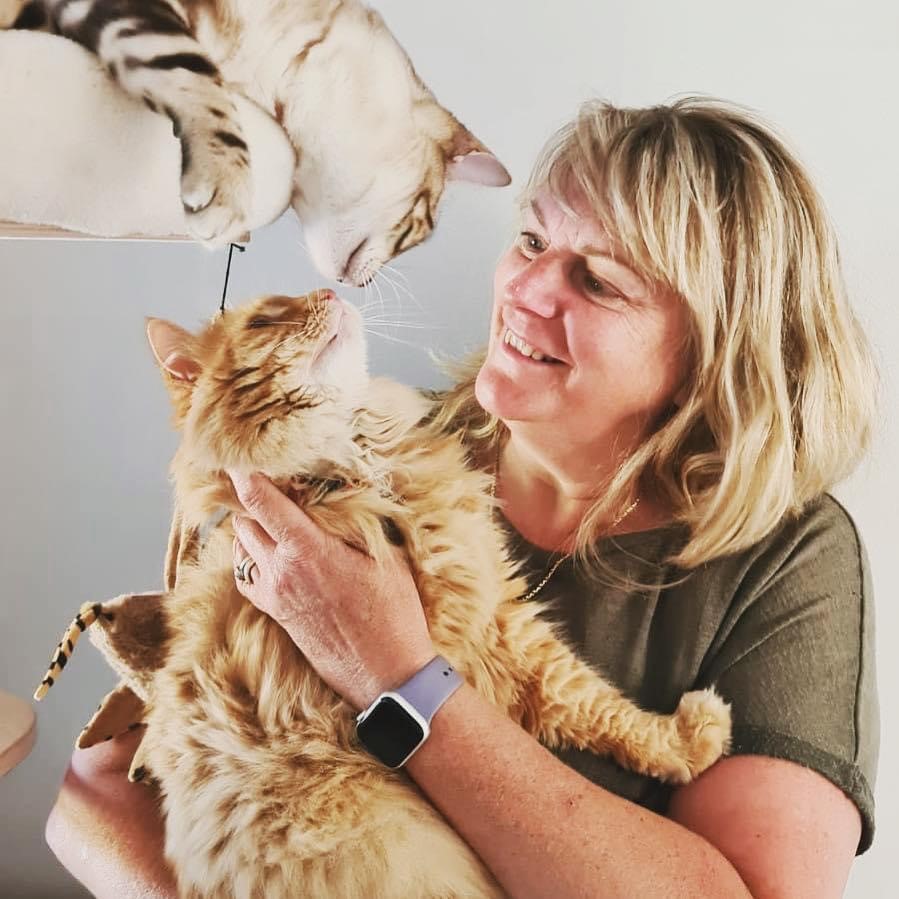
CALMING THE MOVE:
Top tips for you and your cat when moving home
Moving homes can be a stressful experience for humans and this includes our feline companions. Cats are extremely territorial and rely on routine and consistency to feel secure and when their status quo changes they may start to display acute signs of stress which we as their carers need to look out for and prevent where possible.
Preparation and anticipation of this potential stress for your feline friend by considering a different approach and the use of synthetic pheromones along with stress-relieving nutraceuticals, cat parents can help alleviate and even prevent their cat’s stress and provide a smoother transition to their new home for them.
Understanding environmental Cat Stress:
Cats thrive on routine and familiarity, so when their environment suddenly changes due to a house move, it can trigger anxiety and stress. Common signs of stress in cats may include hiding, excessive vocalisation, loss of appetite, soiling around the home and even aggressive behaviour. Additionally, some cats may exhibit physical symptoms such as vomiting or diarrhoea when under stress as well as behavioural ones.
Using Synthetic Pheromones to Ease Cat Stress
The Role of Synthetic Pheromones:
Synthetic pheromones are designed to mimic the natural calming scents that cats release from various glands over their body from their face to their interdigital glands on their feet. Cats use these nonverbal cues as markers around their territory to leave messages to themselves and other cats in the home or neighbourhood of their presence and also give them a sense of security in their boundary markers. These pheromones are undetectable to the human olfactory sense.
Science tells us that there are five facial pheromones and pheromones F1 – F4 are known to be used to mark territories such as object rubbing and providing a territorial signal in areas that the cat is familiar with and this helps to emotionally soothe and calm the cat so it usually these pheromones that are synthetically recreated to be harnessed as a valuable tool in reducing stress for a cat during a house move.
These synthetic blends of pheromones are available in various forms such as diffusers, sprays, and collars and wipes and help to create a familiar and reassuring environment for cats, helping them feel more secure and relaxed.
How Synthetic Pheromones Work:
Synthetic pheromones communicate to cats that their environment is safe and familiar. By mimicking some of the natural facial pheromones that cats produce, synthetic versions can help create a sense of calm and reassurance, even in unfamiliar surroundings. This can be especially beneficial during a move when cats are adjusting to a new home and may feel acutely stressed or anxious
Tips for Using Synthetic Pheromones During a Move:
Prepare in advance: Begin using synthetic pheromones in your current home before the move, don’t just plug in on the day!
Preparation is key to helping your cat associate the synthetic blend with feelings of calm and safety.
Use in Transit: Apply synthetic pheromone spray to your cat’s carrier at least 20 minutes before and during the move to help keep them calm during travel.
Never travel with the cat loose in the car – always use a robust carrier. Leave the carrier out a few hours before with the door open so it’s “normal” ( I randomly bring a carrier out so my cats don’t associate the ‘dreaded box’ to the vets or a road trip – they are far less frightened of it then – so plan ahead! if you regularly bring out the box it won’t heighten any more stress. A carrier that opens at the top is much easier to use as the cat can be gently lifted in or out.
Cover the carrier with a cloth or towel during the journey to keep the cat calm.
You can consider placing bedding in the carrier that the cat normally sleeps on or curls up on at home or an article of clothing belonging to the cat’s favourite person in the carrier.
Wipe a soft cloth around the cat’s face to pick up its scent, rub this around the carrier, especially in the corners, and then leave it in the basket. Utilising its unique facial pheromones too!
Set Up a Safe Space: In your new home, create a designated safe space for your cat with their familiar items such as bedding, toys, and a pheromone diffuser. Bring your cat into a small room in the house that you have prepared in advance with all the essentials that it will need. Food, water, a litter box (use soiled litter from the previous home as this has additional scent markers), a few toys and your cat’s bed.
A good idea is to leave a cardboard box that they can hide inside too. Studies show how providing a box in which a cat may choose to hide overwhelmingly helped a cat or kitten to decompress in a new or strange environment. The box can also be sprayed with a synthetic pheromone blended spray.
The cat should be left alone to decompress for an hour or so in this safe zone and be mindful to keep away any young children or other family pets. Let the cat feel the need to explore its new home in its own time.
Keep loud noises to a minimum and let the cat begin to feel settled.
After a few hours, just check on the cat and speak softly, offering a downward pointed finger towards the cat so it can take on board your scent.
You may want to blink slowly at the cat – a kitty kiss in cat language!
So far so good now after a day or so you may want to introduce your cat to other rooms to which it can have access over the next few days and extra diffusers may be placed in these rooms too.
REMEMBER TO KEEP DOORS AND WINDOWS LOCKED! Your cat won’t know it’s in its new home and may try to escape.
Also, remember to change your cat’s microchip address with the vets and chip database
Don’t be tempted to rush any of the aforementioned steps -TAKE THE TIME THAT IT TAKES SO IT TAKES LESS TIME
Consider using pheromone support to help your cat adjust to its new environment for at least four weeks after the move to prevent and alleviate stress and anxiety.
If you are concerned in any way about any changes in your cat’s behaviour at any time always consult your veterinary practitioner.

Amanda Campion
Clinical Feline Behaviourist

